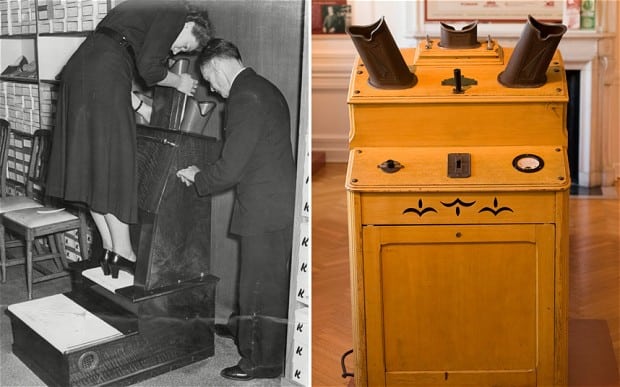There were many scientific innovations during the late 19th and early 20th centuries. Most of these inventions were used to help in the advancement of humanity’s understanding of the world. One good example would be the x-ray. Did you know that x-rays were also used as an elaborate marketing scheme to sell shoes?
Most American shoe stores had x-ray machines to allow customers to see the fit of their feet in their shoes. This was a sales and marketing gimmick employed by the stores. The machines were used mostly on children’s fitting.
What was the Shoe Fitting Fluoroscope?
The shoe-fitting fluoroscope was a device commonly found in shoe stores in the thirties to the fifties. The machine was usually made of a vertical wooden cabinet. At one end of the cabinet was an opening designed to which the feet were placed.
On the top were three viewing ports. One was designed to be used by the person whose feet were in the opening, usually a child. The other viewing port was for the parents, and the third was for the salesman. What would be seen would be a fluorescent image of the bones of the feet and the outline of the shoes.
The machine usually used a 50 kV x-ray tube operating at 3 to 8 milliamps. Essentially, using the fluoroscope is tantamount to standing on top of the x-ray tube, with only about a one-millimeter thick aluminum sheet protecting the user. Some models had control over fluorescence intensities, and others had push-button timers for the exposure time. (Source: ORAU)
The History of the Machine
Many have claimed to have invented the shoe-fitting fluoroscope throughout history, but a certain Dr. Jacob J. Lowe had the strongest claim to invent it. According to researchers Duffin and Hayter, authors of the book Baring the Sole: The Rise and Fall of the Shoe-fitting Fluoroscope, the Boston physician first created his first fluoroscopic device for World War 1 soldiers.
By eliminating the need for soldiers to remove their boots, Lowe was able to speed up the process of checking up injured soldiers. After World War I, Lowe modified the device specifically for shoe-fitting and presented it to the 1920 Boston shoe retailer’s convention.
Lowe gave his invention Foot-O-Scope and became a major investment for shoe retailers with its $900 price tag. An early reference on Foot-O-Scope usage was published in the Pittsburgh Post-Gazette, where it was successfully able to identify a lion tamer’s misaligned big toe on his left foot. (Source: ORAU)
Safety Concerns and The Discontinued Practice
In the late 1940s, the American Standards Association established a safe standard and tolerance dose, an action brought about by new information on the dangers of radiation. Soon, many states followed suit, adhering to standards like children were not allowed to be exposed to the machine’s radiation more than twelve times a year and that feet were only to receive no more than 2 R per 5-second exposure.
By the early 1950s, several professional organizations issued warnings about the continued use of fluoroscopes and the recommendation that licensed physiotherapists should only operate such machines, and later on only by licensed physicians. This signaled the demise of the usage of the machines, with most people seeing it as a salesman gimmick rather than a helpful tool. (Source: ORAU)
